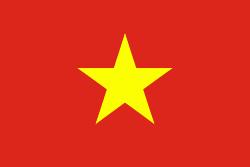Nghĩa Đàn District (Huyện Nghĩa Đàn)
Nghĩa Đàn is a commercial and rural district of Nghệ An province, in the North Central Coast region of Vietnam. As of 2003, the district had a population of 188,871. The district covers an area of 748 km². The district capital is in Nghĩa Bình Commune.
Dong Du Village is about 68 km to the west of Vinh on the way to and from Phong Nha - Kẻ Bàng and Ninh Bình. Dong Du Village is a typical Vietnamese agricultural village in terms of culture and traditions. The village is surrounded by mountains which are mirrored in Khe Lau Lake. Also, similar to other typical traditional Vietnamese villages in the far north of Vietnam, Dong Du Village has golden rice fields in the harvest time, many lakes and waterlily and lotus ponds and colorful gardens, especially the ranges of areca and coconut trees in the sunshine.
Dong Du Village has many historical monuments and an ancient house named Dong Truc which contains cultural and historical values dated back to the Lý and Tran dynasties. In the village, all the alley roads have stone walls. The community-based tourism project has been developed in Dong Du Village since 2001. Visitors can visit Dong Du Village to see water puppet shows and enjoy swimming, kayaking and standup paddle boarding in Khe Lau lake and stay overnight with family in cozy homestays.
Dong Du Village is about 68 km to the west of Vinh on the way to and from Phong Nha - Kẻ Bàng and Ninh Bình. Dong Du Village is a typical Vietnamese agricultural village in terms of culture and traditions. The village is surrounded by mountains which are mirrored in Khe Lau Lake. Also, similar to other typical traditional Vietnamese villages in the far north of Vietnam, Dong Du Village has golden rice fields in the harvest time, many lakes and waterlily and lotus ponds and colorful gardens, especially the ranges of areca and coconut trees in the sunshine.
Dong Du Village has many historical monuments and an ancient house named Dong Truc which contains cultural and historical values dated back to the Lý and Tran dynasties. In the village, all the alley roads have stone walls. The community-based tourism project has been developed in Dong Du Village since 2001. Visitors can visit Dong Du Village to see water puppet shows and enjoy swimming, kayaking and standup paddle boarding in Khe Lau lake and stay overnight with family in cozy homestays.
Map - Nghĩa Đàn District (Huyện Nghĩa Đàn)
Map
Country - Vietnam
 |
 |
| Flag of Vietnam | |
Vietnam was inhabited by the Paleolithic age, with states established in the first millennium BC on the Red River Delta in modern-day northern Vietnam. The Han dynasty annexed Northern and Central Vietnam under Chinese rule from 111 BC, until the first dynasty emerged in 939. Successive monarchical dynasties absorbed Chinese influences through Confucianism and Buddhism, and expanded southward to the Mekong Delta, conquering Champa. The Nguyễn—the last imperial dynasty—surrendered to France in 1883. Following the August Revolution, the nationalist Viet Minh under the leadership of communist revolutionary Ho Chi Minh proclaimed independence from France in 1945.
Currency / Language
| ISO | Currency | Symbol | Significant figures |
|---|---|---|---|
| VND | Vietnamese đồng | ₫ | 0 |
| ISO | Language |
|---|---|
| KM | Central Khmer language |
| ZH | Chinese language |
| EN | English language |
| FR | French language |
| VI | Vietnamese language |















